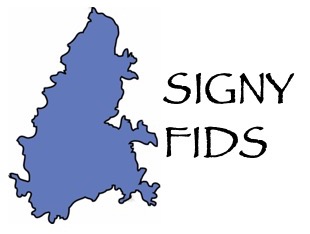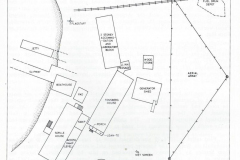The 1980’s brought the Falklands War and a major outcome for BAS was a significantly enhanced budget for the institute to ensure a far greater British presence in the region after the conflict. Where before the Survey had been very constrained financially, particularly with respect to capital items, the institute had now been allocated substantial funding to significantly expand the headquarters in Cambridge, build a new jetty and gravel runway at Rothera, acquire a new research vessel (RRS James Clark Ross) to replace the John Biscoe, and a new long-range four engined aircraft (Dash 7) to directly link the Falklands with Rothera. These developments provided BAS terrestrial and marine scientists with opportunities to broaden out into new polar environments. The drawback with such large-scale capital funding is that it requires enhanced recurrent funding to operate and maintain these capital facilities and in due course BAS was having to go back to ask for increased recurrent funding.
The research across BAS certainly ramped up significantly through the 80’s and the organisation became far more established on the international stage, particularly with BAS physicists at Halley discovering the Ozone Hole. Signy did not benefit on the same scale of those BAS stations further South but there was nevertheless the replacement of the old Boatshed (ex-Clifford House) and the two freezer huts with the very substantial Sorlle House which provided both better storage and more summer accommodation.
The Enforced Winter (1980)
David Rootes
[Extracted from A Concise Account of Signy Island Base H]
|
It had been a busy summer for the Base with various visitors. Most of these departed the island in March but, to the surprise of station personnel, April brought an unseasonably early arrival of pack ice, two weeks before last call. The John Biscoe made several attempts to penetrate the ice but these were stopped when the Director recalled the vessel to UK on April 30th. This left seven extra personnel to an unplanned winter stay on Base. It was the first (and last) time that extra personnel had to winter at Signy, a situation that Stonington had experienced in 1949. Two BAS researchers (Alistair Burn and Andrew Lister) and new Station Commander, David Rootes, were only supposed to be there for the summer whilst three double winterers, Peter Christie and George Hawthorn (Signy), and Tom Lachlan-Cope (Halley), remained South for a third successive year. The early arrival of pack ice promised good fast ice and indeed many trips were made to Coronation over the winter. Mt. Sladen was ascended for the first time by Doug Allan, Phil Shaw and Alister Lister. Relief in December 1980 had to be effected across the sea-ice in Borge Bay after Bransfield cut a channel from the ice edge off the Robertson Islands. Image: Cartoon front cover of the 1981 BASC Magazine |
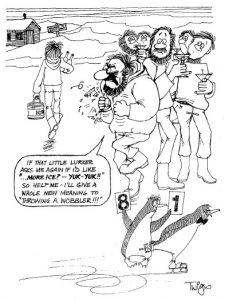 |
So Long, Skidoo
Doug Allen
George Hawthorn and I took a skidoo out one Sunday morning to go and look for Weddell seals off North Point. We were travelling light and fast, both of us on the same machine. I suppose we really should have noticed the suspiciously greyish patch of ice just off the penguin rookery, but the first realisation of trouble was when we felt our speed decreasing and I sensed the rear end of the snow machine dropping. I glanced around. We had almost a rooster tail of slush being kicked up behind us as the drive tracks chewed the thin ice. George immediately steered for a patch of thicker ice, but we both knew with a horrible inevitability that we were not going to make it. We were slowing down too much. In the end it was like the graceful abandoning of the snow machine Titanic. We came to a complete stop, the back end was under water in seconds, but we still had time for both of us to step off and onto the ice, which was just thick enough to take our weight but not the machine’s. It gurgled into the depths while we watched.
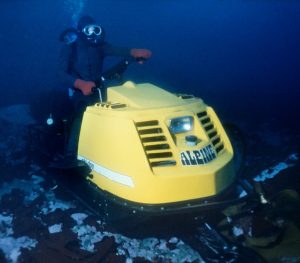
It was only a 20-minute walk back to base, where Smuggler the mechanic watched us arrive on foot, when only half an hour before we had been zooming away on one of his machines. ‘Problems out there?’ he asked. George came back quick as a flash: ‘Nothing serious, just flooded the engine.’ Two days later the ice had thickened enough for us to go safely back to the spot, where we cut a hole, dived to put lifting bags on the machine and brought her to the surface. Full strip down of the engine and she was as good as new.
Another Construction Phase at Signy
David Rootes
[Extracted from A Concise Account of Signy Island Base H]
The demand for improved biological facilities and further storage space at Signy resulted in the planning of a new building for 1980-81 summer. To make room for the new building, the outside biostore from 1968, the old boatshed from 1955 and the CT hut (from 1968) were demolished. As often occurs, things did not go entirely smoothly. The sea-ice relief in December 1980 limited the amount of cargo that could be unloaded. Construction of the new building, Sorlle House, named for whaling captain, Petr Sorlle, who had given his wife’s name to Signy Island, was further hampered when the Biscoe lost a couple of propellor blades and had to return to UK, leaving concrete for the Sorlle House foundations stranded for a time in Port Stanley. However, once constructed, Sorlle House was fitted out over a 12 month period. The ground floor housed new cool, cold and dry food stores, two large constant temperature science rooms, a skidoo store and a new Dive Store complete with a two/four man recompression chamber. Upstairs was given over to storage for biological equipment, a chandlery and electrical stores, a magnificent travel store and a small recreation room which, in summer doubled as extra sleeping accommodation (albeit in sleeping bags on the floor).
Signy – the Hottest Night (1982)
Bill Block
The lounge in the Plastic Palace on Signy Island was relatively quiet and quite peaceful – it was after dinner, several folk were reading, a few nodding off and a game of ‘Uckers’ was in progress. The silence occasionally broken by the clack of moving the blobs on the Uckers board interspersed by cries of “Gotcha” and the like. It was warm, someone got up and opened the small windows to get some fresh air into the room. There was no breeze. Around 9 pm most Base members, feeling somewhat over-heated inside had migrated outdoors, wandering about on the old flensing plan and lounging in the boats at the top of the slip with cooling drinks in hand. We could not understand why we were so warm.
It had been a ‘dingle’ day, unusual for Signy in summer, with the sun much in evidence during the day. In the afternoon I had walked across the Orwell Glacier, avoiding the crevasses, to Marble Knolls and up Limestone Valley to Jane Col to sample at the research site. My shirt was off for most of the morning doing fieldwork! The melt water in the stream tumbling down the valley was strangely refreshing to hear. Snow algae were beginning to colour the snow beds a deep red colour. Walking across the ice cap to Tioga Hill and onto Garnet Hill the gusts of warm wind on the face surprised me. I descended along Moraine Valley and back to Base to a G & T in sunshine on the jetty. Dinner was special that evening in honour of diving officer Ken Cameron’s birthday.
As the evening wore on most of us realised that Friday 29 January 1982 was not going to be a typical end to the day as temperatures were climbing not falling. Grabbing a beer, I headed down to the jetty hoping to catch a breeze at the end of it. Half way along the structure was a large gap (the jetty was being rebuilt due to the ravages of winter sea ice), which required a good leap to cross. Sitting at the end of the jetty, my feet dangling over the calm sea, I gazed towards North Point and then around to follow the coastline of Coronation Island. As we approached midnight the air was still balmy, several Fids appeared in shorts usually worn in South America, music poured out of the open windows of the Palace and we had moved into party time! The sky was clear but small clouds were beginning to tumble down the slopes of Wave Peak on Coronation Island. Cynan Ellis-Evans joined me at the end of the jetty; we sat enjoying the warm evening and putting the world to rights helped by a few drinks. Much later, scrambling back along the jetty initially proved beyond me, but helped by Cynan, a leap of faith took me across the by now tide-filled “chasm” which mysteriously had grown wider than before!
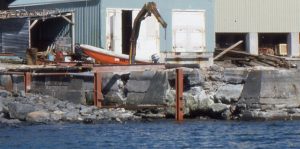
Several Fids complained of being unable to sleep that night (an almost unknown practice at Signy!). At around 3am the next day a record high temperature of +19.8⁰C was recorded – little did we realise its significance. According to John King, who analysed the data, it occurred through a combination of a warm subtropical air stream from the north descending as a föhn wind off the mountains of Coronation Island to sea level. Signy became subtropical for a while – it made a change from ‘low mank’.
Cynan contacted his wife to tell her of this entertaining evening – only to get an earful back as she had been enduring temperatures of -18 deg. C in Cambridgeshire at the same time followed by burst water pipes flooding the kitchen!
.……and now the science
Basking in the Banana Belt
John King
Fids at stations further south have often jokingly referred to their Signy colleagues as ‘living in the Banana Belt’ because of the island’s relatively mild maritime climate. Now it is official – Signy holds the record for the highest temperature ever recorded in the Antarctic region (defined as ‘all land and ice shelves south of 60°S’). During 2016, I was a member of a World Meteorological Organisation committee that was tasked with establishing the extreme maximum temperature record for the Antarctic. After examining data from a number of Antarctic locations, we concluded that the temperature of +19.8°C measured at Signy on 30 January 1982 was indeed a record for the region. While maximum temperatures in the low teens are not unusual at Signy, this record was exceptional. A monthly extreme maximum temperature of 18°C or higher has only been recorded three times in the Signy climate record.
So what caused temperatures at Signy to reach levels more typical of a summer day in Cambridge than those experienced across much of the Antarctic? At the time, weather systems in the South Atlantic were bringing exceptionally warm subtropical air towards Signy. As this air moved south across the cold Southern Ocean it cooled at low levels but remained very warm above 1 km altitude. With the wind blowing from the north, this warm air was brought back towards the surface as the air descended on the lee (south) side of the mountains of Coronation Island. This phenomenon, known as a föhn wind, is relatively common at Signy, but the combination of such a warm air mass with a föhn event was exceptional.
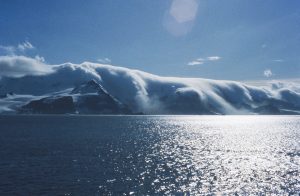
A föhn event over Coronation
Interestingly, temperatures at nearby Orcadas station on Laurie Island remained close to the seasonal average throughout the duration of the extreme warm event at Signy. While the central mountain ridge of Coronation Island peaks at over 1 km altitude, Laurie Island is relatively low-lying and could not generate a föhn event capable of bringing the warm air at 1 km down to the surface. Temperatures at Signy are, on average, 0.2°C warmer than at Orcadas and it is possible that the occurrence of föhn at Signy (but not at Orcadas) explains much of this difference.
Surprisingly, the record of January 1982 does not get a mention in the station’s meteorological report, possibly because the outbreak of the Falklands War a few weeks later dominated events that year. However, Fids at Signy at the time certainly remember the exceptional event. I would be pleased to hear from anyone with first-hand experience of the event – please get in touch with me at jcki@bas.ac.uk.
The Falklands Crisis
David Rootes
[Extracted from A Concise Account of Signy Island Base H and amended with notes by Cynan Ellis-Evans]
The events of April 1982 shocked base personnel, as everybody else, and interrupted the Stanley radio link for the first time. During those first few weeks, Signy acted as a coordinating hub between Bransfield and the South Georgia field parties, having maintained contact with Grytviken until the Argentine military occupied the station on 3 April 1982. Signy was actually talking with the Grytviken BC and the senior military officer, Lt. Mills when the Argentinians started their assault and the BC was instructed by Mills to get to cover before the Marines opened fire. Signy was the last BAS station to be relieved by Bransfield, which then sailed north to UK. En route those on board heard of the removal of the Grytviken Fids and the Marine detachment to Buenos Aires, and the announcement, at one point, that the Bransfield had been captured by the Argentinians off the South American coast whilst we were actually quietly sailing up the east side of the Atlantic, as the British Task Force headed south. Until Stanley was finally re-taken by the Task Force in June, radio traffic was severely limited and was passed through the US Palmer Station on Anvers Island via Washington to UK.
The closure of Grytviken Station was the first major change in BAS resulting from the Falklands War. The second was the events had highlighted the need for a secure radio channel between Cambridge HQ and the stations. Although Stanley was quickly able to recommence the telex link to UK, it was decided to install satellite communication equipment at the stations and on the ships. Signy was the first station to test the the link and inaugural phone calls were made to HQ in December 1982. By 1983-84 both the ships and all the stations (except Bird Island which maintained a HF link with Signy) were fitted with sat comms (phone and fax) and so the radio link with Stanley at long last came to an end. Radio comms with ships and stations continued, including the legendary inter-station Goon Show.
Signy As it Stands – Just
Ian Lovegrove
[An article for the BASC Magazine to mark the 40th Anniversary of Base H Signy Island and the retirement of BAS Director Dick Laws.]After forty years association with Signy, Dr Laws, on his last visit as BAS Director, recorded in the Cummings Hut Journal that “the views and wildlife remain the same – superb.” Certainly, to any would-be visitor, no matter from how long past, there would seem little apparent change. Nest sites may have moved yet the prions, cape pigeons, penguins, shags and our numerous petrels are still with us. Even skuas, with their sweeping dives, continue in their game of Fid harassment. Mosses and lichens appear much the same, though undoubtedly a little older and lakes continue to freeze and thaw.
The Signy weather remains unchanged – at times it could be thought that the term “mank” was especially devised for the South Orkneys with eight-eighths stratus at one thousand feet being the norm. Foul days of wind, rain and snow continue, though as ever the odd day of sunshine raises both smiles and the temperature.
One very notable change would be the vast increase in fur seals that has taken place over the past few years. The 13,353 total, including five pups born this year (1987), now covers many parts of the island and, in an attempt to protect the more vulnerable study sites (notably the Back Slope and its research sites), we have even taken to erecting electric fences. Fur seals now live close to the Base.
As a returning visitor one would notice other changes. Gone are the two constant-temperature huts which, along with the old Boatshed, have made way for a large storage building, Sorlle House, that also now houses the diving facility. Tonsberg House and the Plastic Hut continue outwardly unchanged yet a closer inspection would reveal the many interior refashionings that have followed their chequered lives.
Outside, the railway still exists, though it no longer runs along the length of the jetty. All that remains is a branch line up to the fuel dump. This year a refurbished skidoo engine again provided mechanical power to haul drums up-hill on the wagon. Time-honoured Fid-power increasingly takes second place. You would still see little change in Fid resourcefulness, which started back in the 1940’s/50’s with the “utilising” of the remains of the old whaling station. In good Fid style items continue to be skillfully adapted and converted. Even the old loo shed from outside the Plastic Hut is now the hazardous chemicals store. Any connection I ask?
As always, space remains at a premium and when, this year, we welcomed three female scientists on Signy the need arose to create an extra bathroom facility and hence the new addition of an outside toilet. This new venture of having women on Base for the summer has been quite a success – a first for Signy and a change for the future.
Technology has encroached. Even the near-sacred ritual of snow blocking has, with the introduction of a reverse-osmosis plant in summer 1985/86, (in place of the far less reliable distillation system) been superceded. Abundant water for all and, following the installation of two containerised generators in the same year, there is also power a’plenty.
Various pointers from the past can still be seen; dog chains from the spans; an old “British Crown Land” sign; the whalers’ graves over on Cemetery Flats; even the bedding timbers for the generators installed in 1947. Whaling artifacts also abound both above and below the water around the island
Diving continues but gone are the Seagull engines and the various clinker-built boats. Now, along with the work launch Serolis, four inflatables – one being rigid-hulled – and a number of substantial 40 HP outboard engines help the base maintain the marine programme and access to other parts of both Signy and Coronation Islands.
Scientists from more recent years may be quietly amused by the following from a 1953 report: “Signy Island has now been occupied for seven years. The island has been thoroughly investigated from a scientific point of view during the period and there only remains the continuous meterological programme.” In this short account it is difficult to do justice to the current scientific endeavours, though rest assured, there are many areas still to be investigated.
Some things never change and the visitor would witness such classic activities as gash, Saturday dinner, scrub-out and everyone contributing to the other routine maintenance jobs around Base. The joys of make do and mend.
It is the people that come and go. The now more frequent turnover of summer staff possibly creates a higher state of flux in base life but no doubt the visitor would find that the people here have still come South for something other than just a mere job. That certain zest for Antarctic life remains. Fun is still to be had; impromptu parties punctuate life whilst the island in all its’ aspects continues to be greatly enjoyed.
If the present Fids were to return in forty years then it is hoped that, amongst the structural changes that will no doubt have taken place, the atmosphere of Signy would be little changed. I would like to feel that the Fid spirit lived on.
Will She Fit in the Boatshed?
Michael Abbott
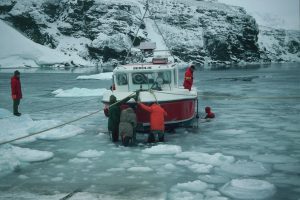
The first Serolis workboat arrived at Signy in the 1975-76 summer as a significant uplift for the marine research programmes. However it did have a number of shortcomings (The A-frame for one) that did somewhat compromise its intended capabilities.
In summer 1987/88 summer a replacement workboat arrived. Somewhat more substantial than its predecessor and with a more capable specification it operated at Signy until the station switched to summer-only status in the mid-nineties.
This picture was supplied by Michael Abbott who commented that
“I have a lot of fond memories of life on base during the winters of 1987 & 1988, and surrounding summers. it’s good to see my biggest build project on base is still standing…..the raising of the boat shed roof to accommodate the new workboat which arrived in the summer of 87/88.
Although there was talk at HQ that the name of the new boat would be Serolis, those of us on base had declared that the name should be different, being a new new boat. We decided to name her Pomona and thought that HQ were going along with this until she turned up on base with the name Serolis across her cabin (see above). I think the name was removed during the winter!”
Click on the links below to get to a relevant page or use the pull down menu under the Stories tab.
| Timeline | 1950’s | 1980′s |
| Pre – 1947 | 1960’s | 1990’s |
| 1947-49 | 1970’s | 2000 on |
